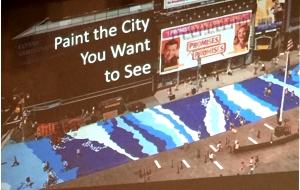
What used to be a very seedy, dirty and crowded area of New York City has undertaken a dramatic renewal as a place for people to linger, chat, and just hang out. Even though the land on Broadway between 42nd and 47th Streets is less than .01 per cent of the actual surface of New York City, it is responsible for 11 per cent of the city’s economic output.
With 330,00 people visiting daily, Times Square has a mix of about 56 per cent locals to 44 per cent of tourists. Through Janette Sadik-Khan’s championing of Times Square as a people not a vehicle place, there has been a remaking of this place by simply making it more and more pedestrian friendly.

Walk Metro Vancouver was in New York City in May 2009 when Broadway Avenue was being closed down for traffic, and the NYC Department of Transportation and the Department of Design and Construction got rid of the old foggy stuff in the square and brought in streamlined fifty foot long granite benches. The transformation was immediate. People sat down on what ever seating device was available, including the green stamped concrete.
As reported in Mic.com, the architecture and landscape firm Snohetta led the process to design the new plaza, including the public and city officials in the discussions.Curbs were eliminated, the “temporary” pedestrian plazas were made permanent. Over twenty agencies and public interest groups had previously been involved in plans to change this area ,with none successful. So what made the difference?
Craig Dykers, the founding partner of Snohetta observes: “For half a century, numerous plans for Times Square had been proposed by designers to help Times Square meet its changing needs and manage pedestrian and vehicular congestion. None of these plans found traction or were approved.” But by recognizing that 300,000 people a day travel by foot through the area and making those pedestrians~and their interaction with the space~ a priority, this has been a great success. With the project officially completed in 2016, “There’s been a 20% decrease in crime, a 40% decrease in pedestrian injuries and a 60% decrease in pollution.”
Eighty per cent of users say the space feels safer, and 93 per cent say it’s a more pleasant place. “Cities need to be smart,” Craig Dykers stated. “It is critical now more than ever to evaluate how much space is needed for cars and traffic and ask if there is space that would be better tailored to pedestrian use.“In each case, we must ask: Does removing the street provide value for users as well as adjacent businesses? How can we continue to cultivate open, vibrant and unique public spaces that increase public safety and promote diverse ways of thinking? These are questions that are being asked with greater urgency, especially as issues of pedestrian safety and secure public space are more pressing than ever.”


